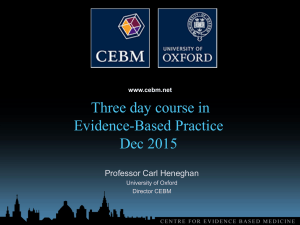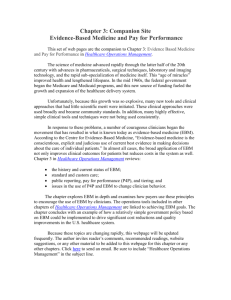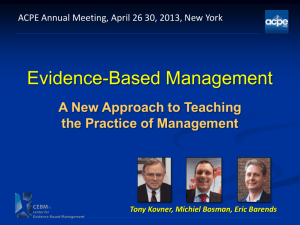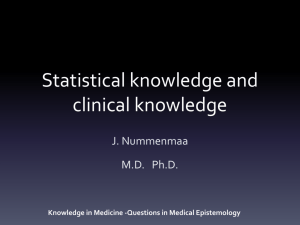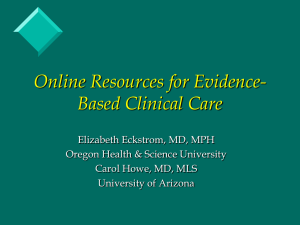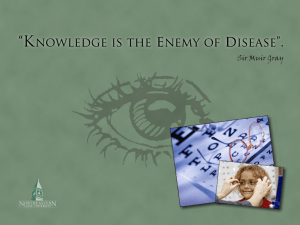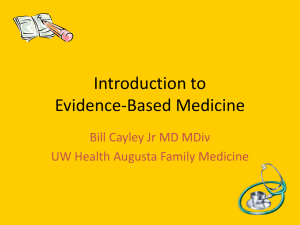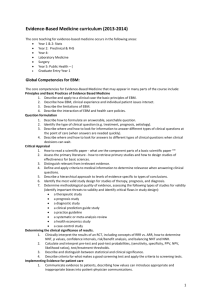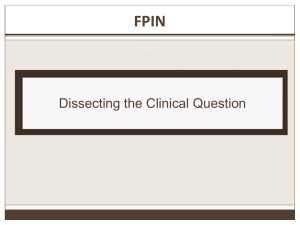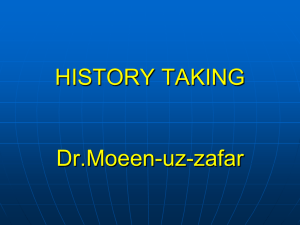Lecture-1-EBM-year4-introduction-2014
advertisement
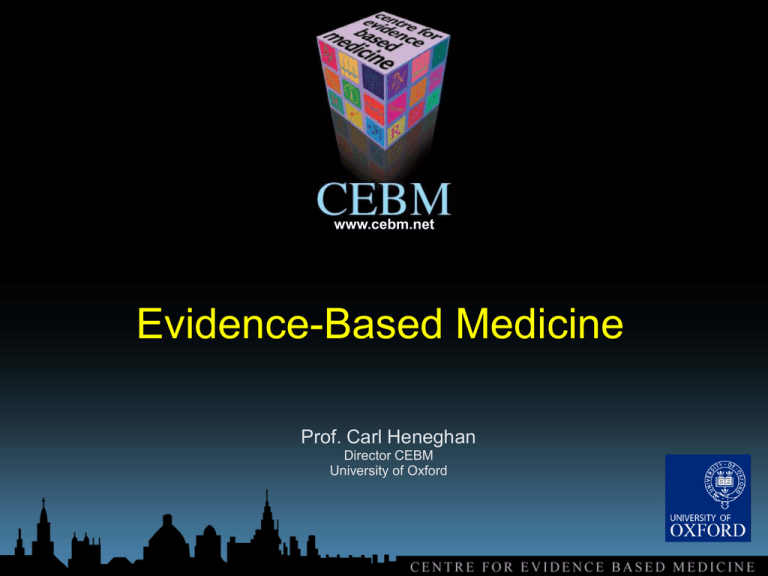
www.cebm.net Evidence-Based Medicine Prof. Carl Heneghan Director CEBM University of Oxford www.cebm.net What is Evidence-Based Medicine? “Evidence-based medicine is the integration of best research evidence with clinical expertise and patient values” Why do we need EBM? Why do we need RANDOMIZED CONTROLLED TRIALS ? www.cebm.net In the early 1980s newly introduced antiarrhythmics were found to be highly successful at suppressing arrhythmias. Not until a RCT was performed was it realized that, although these drugs suppressed arrhythmias, they actually increased mortality. The CAST trial revealed Excess mortality of 56/1000. By the time the results of this trial were published, at least 100,000 such patients had been taking these drugs. • For every 1000 patients treated 65 more will be alive at 1 month if treatment is administered in the first hour – the ‘golden hour’ – after symptom onset, compared with not giving thrombolysis; • 37 lives are saved for every 1000 patients treated in the 1–2 hour interval after symptom onset; • 26 lives are saved for every 1000 patients treated in the 2–3 hour interval after symptom onset; • 29 lives are saved for every 1000 patients treated in the 3–6 hour interval after symptom onset; • 20 lives are saved for every 1000 patients treated in the 7–12 hour interval after symptom onset. • Allocation to antiplatelet therapy produced a highly significant reduction (P<0.00001) of 38 per 1000 in the risk of suffering a subsequent vascular event Pain relief Beware of text books “A 21st century clinician who cannot critically read a study is as unprepared as one who cannot take a blood pressure or examine the cardiovascular system.” BMJ 2008:337:704-705 EBM as a medical student? Be aware that treatment options should be based on clinical need and the effectiveness of treatment options, and that decisions should be arrived at through assessment and discussion with the patient Must be aware of their responsibility to maintain their knowledge and skills throughout there careers. Students are expected to keep up to date and to apply knowledge necessary for good clinical care. what skills will you need to keep up to date with the best evidence? Must be aware of their responsibility to maintain their knowledge and skills throughout there careers. Students are expected to keep up to date and to apply knowledge necessary for good clinical care. • to find the evidence more efficiently • to appraise the quality of the evidence more effectively • to use good quality evidence more systematically about 1/2 of ‘valid’ evidence today is out of date in 5 years about 1/2 of valid evidence is not implemented ScienceCartoonsPlus.com the steps of practicing EBM 1. Ask a focused question. 2. Track down the evidence 3. Critically appraise evidence for its validity, effect size, precision 4. Apply the evidence in practice: a. amalgamate the valid evidence with other relevant information (values & preferences, clinical/health issues, & system issues) b. implement the decision in practice 1. Ask a focused question. Patient presenting with MI ‘Background’ Questions About the disorder, test, treatment, etc. a. Root* + Verb: “What causes …” b. Condition: “HIV?” •* Who, What, Where, When, Why, Patient presenting with MI 1. What are the symptoms and signs of someone presenting with MI? 2. What are the diagnostic tests for MI? 3. What are the causes of MI? 4. What are the treatments of MI? Know your background Patient presenting with MI Foreground’ Questions About actual patient care decisions and actions For treatment 4 (or 3) components: In Patients with a MI Does (I) cholesterol lowering therapy Compared to placebo reduce mortality (O) During the scheduled treatment period, there were 3832 (8·5%) deaths among the 45 054 participants allocated a statin compared with 4354 (9·7%) among the 45 002 controls. This difference represents a 12% proportional reduction in all-cause mortality per mmol/L LDL cholesterol reduction (RR 0·88, 95% CI 0·84–0·91; p<0·0001; figure 1). Secondary Prevention Long-term Intervention with Pravastatin in Ischemic Disease (LIPID) Study 9,014 patients with a history of MI or hospitalization for unstable angina randomized to pravastatin (40 mg) or placebo for 6.1 years 24% RRR 8.3 6.4 CHD Death (%) 9 6 3 0 P<0.001 Placebo Pravastatin Statins provide significant benefit across a broad range of cholesterol levels CHD=Coronary heart disease, MI=Myocardial infarction, RRR=Relative risk reduction LIPID Study Group. NEJM 1998;339:1349–1357 Patient presenting with MI 1. How common is the problem Prevalence 2. Is early detection worthwhile Screening 3. Is the diagnostic test accurate Diagnosis 4. What will happen if we do nothing Prognosis 5. Does this intervention help Treatment 6. What are the common harms of an intervention Treatment 7. What are the rare harms of an intervention Treatment Size of Medical Knowledge • NLM MetaThesaurus – 875,255 concepts 1 disease per day – 2.14 million concept names for 30 years • Diagnosis Pro – 11,000 diseases – 30,000 abnormalities (symptoms, signs, lab, X-ray,) – 3,200 drugs (cf FDAs 18,283 products) To cover the vast field of medicine in four years is an impossible task. - William Olser why do we need to use evidence efficiently? Per Articles Medical Articles perYear Year 2500000 5,000? per day 2000000 1500000 2,000 per day 1000000 75 per 500000 day 0 Biomedical MEDLINE Trials Diagnostic? EBP: informing decisions with the best up-to-date evidence Median minutes/week spent reading about my patients Self-reports at 17 Grand Rounds: • • • • • • Medical Students: House Officers (PGY1): SHOs (PGY2-4): Registrars: Sr. Registrars Consultants: 90 minutes 0 (up to 70%=none) 20 (up to 15%=none) 45 (up to 40%=none) 30 (up to 15%=none) – Grad. Post 1975: – Grad. Pre 1975: 45 (up to 30%=none) 30 (up to 40%=none) clinical evidence increasing so rapidly we need better skills to keep up-to-date more efficiently than previous generations of clinicians more efficiently Bastian, Glasziou, Chalmers PLoS 2010 Vol 7 | Issue 9 | e1000326 the steps of practicing EBM 1. ask a focused question. 2. Track down the evidence 3. Critically appraise evidence for its validity, effect size, precision 4. apply the evidence in practice: a. amalgamate the valid evidence with other relevant information (values & preferences, clinical/health issues, & system issues) and make an evidence-based decision; and b. implement the decision in practice the steps of practicing EBM 1. Ask a focused question. 2. Track down the evidence 3. Critically appraise evidence for its validity, effect size, precision (NEXT month) 4. Apply the evidence in practice: a. amalgamate the valid evidence with other relevant information (values & preferences, clinical/health issues, & system issues) b. implement the decision in practice In the next 4 weeks • Try to ask for one patient you have seen: 1. 2. 3. 4. 5. What causes the disease? How was the disease diagnosed? How was the patient treated? What is the natural history of the disease? Consider formulating a PICO And try to find some evidence
